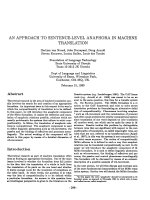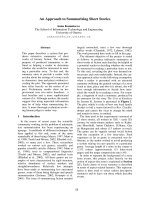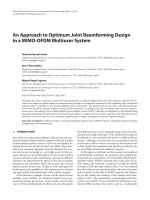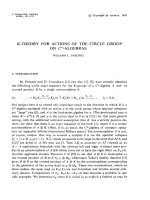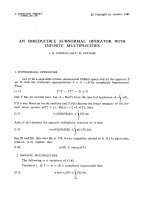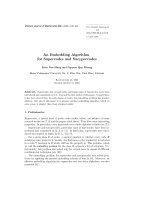Báo cáo toán học: "An Introduction to q -Species" doc
Bạn đang xem bản rút gọn của tài liệu. Xem và tải ngay bản đầy đủ của tài liệu tại đây (136.88 KB, 15 trang )
An Introduction to q -Species
Kent E. Morrison
Department of Mathematics
California Polytechnic State University
San Luis Obispo, CA 93407
Submitted: Oct 22, 2005; Accepted: Nov 19, 2005; Published: Nov 25, 2005
Mathematics Subject Classifications: 05A15; 05A30, 15A33, 18B99
Abstract
The combinatorial theory of species developed by Joyal provides a foundation
for enumerative combinatorics of objects constructed from finite sets. In this pa-
per we develop an analogous theory for the enumerative combinatorics of objects
constructed from vector spaces over finite fields. Examples of these objects include
subspaces, flags of subspaces, direct sum decompositions, and linear maps or ma-
trices of various types. The unifying concept is that of a “q -species,” defined to be
a functor from the category of finite dimensional vector spaces over a finite field to
the category of finite sets.
1 Definitions
The combinatorial theory of species originated in the work of Joyal [7] in 1981 and has
developed into a mature theory for understanding classical enumerative combinatorics and
its generating functions [1]. More than thirty years ago Goldman and Rota [5, 6] began
the systematic exploration of the “subset-subspace” analogy, the foremost example being
the analogy between the binomial coefficients, which count subsets, and the q-binomial
coefficients, which count subspaces. Their work has an interesting prehistory that is
outlined in a short survey by Kung [10]. The aim of this paper is to further the subset-
subspace analogy with the development of the theory of species for structures associated
to vector spaces over finite fields.
This is not the first appearance of q-analogs nor the first use of vector spaces in
the theory of species. D´ecoste [3, 4] defined canonical q-counting series by means of q-
substitutions in the cycle index series and in the asymmetry index series introduced by
Labelle [11]. Also, Joyal [8] introduced the concept of a “tensorial species,” which is a
functor from the category of finite sets (with bijections) to the category of vector spaces
over a field of characteristic zero. However, the approach in this paper is different from
the electronic journal of combinatorics 12 (2005), #R62 1
the earlier work. First of all, we are not q-counting ordinary combinatorial structures
but counting structures associated to vector spaces over the field of order q. Second, a
q-species is a functor from a category of vector spaces to the category of sets, whereas a
tensorial species is a functor in the opposite direction.
First we recall the definition of a combinatorial species. Let B be the category whose
objects are finite sets and whose morphisms are bijections. A species is a functor F : B →
B [7, 1]. For a finite set U,thesetF [U] is a collection of structures on the set U.Let
F
q
be the finite field of order q. Define V
q
to be the category whose objects are finite
dimensional vector spaces over F
q
and whose morphisms are the linear isomorphisms.
Definition 1.1. A q -species (or species of structures over F
q
) is a functor F : V
q
→
B.
Let F
(N)
q
be the vector space of countable dimension whose elements are vectors
(a
1
,a
2
, ) with a finite number of non-zero components. Let e
1
,e
2
, be the standard
basis and let E
n
be the span of e
1
, ,e
n
.Then
E
0
⊂ E
1
⊂···⊂E
n
⊂ E
n+1
⊂···
is an increasing sequence of subspaces whose union is F
(N)
q
.Letγ
n
be the order of the
general linear group GL
n
(q) of invertible n×n matrices over F
q
and define γ
0
= 1. Recall
that
γ
n
=
n
i=0
(q
n
− q
i
).
Definition 1.2. The generating series of a q-species F is the power series
F (x)=
n≥0
f
n
γ
n
x
n
,
where f
n
= |F [E
n
]| is the number of elements in F [E
n
].
Example 1.3. The q-species of elements ε is defined by ε[V ]=V and ε[φ]=φ for an
isomorphism φ : V → W .
ε(x)=
n≥0
q
n
γ
n
x
n
.
Example 1.4. The q-species of projective spaces P with P[V ] defined to be the set
of one-dimensional subspaces of V . For an isomorphism φ : V → W and L ∈ P[V ], we
define P[φ](L)=φ(L). The generating series is
P(x)=
n≥0
[n]
q
γ
n
x
n
,
where [n]
q
=1+q + q
2
+ ···+ q
n−1
is the q-analog of n. (Note that [0]
q
=0.)
the electronic journal of combinatorics 12 (2005), #R62 2
Example 1.5. The q-species of endomorphisms is defined by F [V ]=End
F
q
(V )and
F [φ](α)=φ ◦ α ◦ φ
−1
for φ : V → W and α ∈ End
F
q
(V ). The generating series is
F (x)=
n≥0
q
n
2
γ
n
x
n
.
Example 1.6. The q-species of automorphisms is defined by F [V ]=Aut
F
q
(V )and
F [φ](α)=φ ◦ α ◦ φ
−1
for φ : V → W and α ∈ Aut
F
q
(V ). The generating series is
F (x)=
n≥0
γ
n
γ
n
x
n
=
1
1 − x
.
Example 1.7. For the q-species of ordered bases we define F [V ]tobethesetof
n-tuples (v
1
,v
2
, ,v
n
) ∈ V
n
where n =dimV and the v
i
are a basis of V . For an
isomorphism φ : V → W we define
F [φ](v
1
, ,v
n
)=(φ(v
1
), ,φ(v
n
)).
The generating series is also
F (x)=
1
1 − x
.
Example 1.8. The q-species of vector spaces V is defined by V[V ]={V } with gener-
ating series
V(x)=
n≥0
x
n
γ
n
.
The q-species of non-zero vector spaces V
+
is defined to be
V
+
[V ]=
∅, if dim V =0,
{V }, if dim V>0.
with generating series
V
+
(x)=
n≥1
x
n
γ
n
.
Example 1.9. The q-species F defined by F [V ] being the set of k-dimensional sub-
spaces of V has generating series
F (x)=
n≥0
n
k
q
x
n
γ
n
,
where
n
k
q
=
γ
n
γ
k
γ
n−k
q
k(n−k)
is the q-binomial coefficient.
the electronic journal of combinatorics 12 (2005), #R62 3
Example 1.10. Let Γ be a group. The q-species of representations is defined by
F [V ]=Hom(Γ, Aut
F
q
(V )). For an isomorphism φ : V → W and a representation
ρ :Γ→ Aut
F
q
(V ). we have
F [φ](ρ)=φ ◦ ρ ◦ ρ
−1
.
The generating series depends on Γ. Some results for finite groups are given in [2]. For
cyclic groups one may also consult [13].
Remark 1.11. Additional examples of generating series of q-species are given in [13].
They include direct sum decompositions (splittings), flags of subspaces, linear and pro-
jective derangements, and diagonalizable, cyclic, or separable endomorphisms.
Definition 1.12. Two structures s, t ∈ F [V ]areisomorphic, indicated s ∼ t,ifthere
exists α ∈ Aut
F
q
(V ) such that F[α](s)=t. The number of isomorphism classes in F[E
n
]
is denoted by
f
n
and the type generating series of F is the formal power series
F (x)=
n≥0
f
n
x
n
.
Example 1.13. The q-species of ordered bases has only one isomorphism type in each
dimension. Thus,
F (x)=1/(1−x). The q-species of automorphisms, which has the same
generating series as the q-species of ordered bases, has for
f
n
the number of conjugacy
classes of invertible n × n matrices. It is shown in [13] that the type generating series is
F (x)=
r≥1
1 − x
r
1 − qx
r
.
In order to define the cycle index series of a q-species we summarize the rational
canonical form of a linear endomorphism. For σ ∈ End
F
q
(V ), V is a module over F
q
[z]
with f(z) · v defined to be f (σ)(v). Then V decomposes uniquely as a direct sum of
primary cyclic modules, which are modules of the form F
q
[z]/(φ
i
) for some monic, irre-
ducible polynomial φ and some positive integer i.Lete
φ,i
(σ) be the number of copies of
F
q
[z]/(φ
i
) that occur in the decomposition of V . These integers are the invariants of σ
that completely describe its conjugacy class within End
F
q
(V ). There is a basis of V for
which the matrix representation of σ is a block diagonal form consisting of e
φ,i
copies of
the companion matrix of φ
i
. An endomorphism is an automorphism precisely when the
polynomial z does not occur among the invariants.
Definition 1.14. The cycle index series of a q-species F is a formal power series in an
infinite number of variables x
φ,i
where φ ranges over the irreducible monic polynomials in
F
q
[z], other than φ(z)=z,andi is a positive integer. We define this series to be
Z
F
=
n≥0
1
γ
n
σ∈Aut(E
n
)
fix F [σ]
φ,i
x
e
φ,i
(σ)
φ,i
,
where fix F [σ] is the number of fixed points of F [σ].
the electronic journal of combinatorics 12 (2005), #R62 4
Remark 1.15. The cycle index series defined here is not the same as those defined by
Kung [9] and Stong [14], although it bears a strong resemblance to them.
The cycle index series Z
F
can be specialized to give both the generating series
F (x)
and the type generating series
F (x). In order to do so it is helpful to order the monic
irreducible polynomials by putting z − 1 first, then the rest of those of degree one, and
then in order of increasing degree. Then we use the following equivalent notations:
Z
F
= Z
F
((x
φ,i
)) = Z
F
((x
z−1,1
,x
z−1,2
, ,x
z−1,i
, ), ,(x
φ,1
,x
φ,2
, ,x
φ,i
, ), ).
Proposition 1.16. The generating series of F is obtained from Z
F
by setting x
z−1,1
= x
and by setting x
z−1,i
=0for i ≥ 2 and x
φ,i
=0for all other φ and i. That is,
F (x)=Z
F
((x, 0, 0, ), (0, 0, ), ,(0, 0, ), ).
Proof.
Z
F
((x, 0, 0, ), (0, 0, ), ,(0, 0, ), )=
n
1
γ
n
fix F [I
n
] x
n
=
n
f
n
γ
n
x
n
=
F (x).
Proposition 1.17. The type generating series
F (x) is obtained from Z
F
by setting x
φ,i
=
x
i
for all φ and i.
Proof.
Z
F
((x, x
2
, ,x
i
, ), (x, x
2
, ,x
i
, ), )=
n
1
γ
n
σ∈Aut(E
n
)
fix F[σ]
φ,i
x
ie
φ,i
(σ)
=
n
1
γ
n
σ∈Aut(E
n
)
fix F[σ]x
φ,i
ie
φ,i
(σ)
=
n
1
γ
n
σ∈Aut(E
n
)
fix F[σ] x
n
=
n
f
n
x
n
.
The last step uses Burnside’s Lemma for the number of orbits of a finite group action. In
this case the orbits of Aut(E
n
)actingonF [E
n
] are the isomorphism classes of structures
in F [E
n
].
Definition 1.18. Two q-species F and G are isomorphic q-species if they are isomorphic
as functors, i.e. there exists an invertible morphism of functors (natural transformation)
η : F → G. We consider isomorphic q-species to be equal and write F = G.(Theterm
“combinatorially equal” is used by Bergeron, Labelle and Leroux [1].)
the electronic journal of combinatorics 12 (2005), #R62 5
2 Sums and Products
Definition 2.1. Given q-species F and G we define their sum q-species F + G by
(F + G)[V ]=F [V ] G[V ] (disjoint union)
(F + G)[φ](s)=
F [φ](s), if s ∈ F [V ],
G[φ](s), if s ∈ G[V ].
The product q-species F · G is defined on objects by
(F · G)[V ]=
V
1
⊕V
2
=V
F [V
1
] × G[V
2
].
For an isomorphism φ : V → W and for (s, t) ∈ F [V
1
] × G[V
2
] we define
(F · G)[φ](s, t)=(F [φ
1
](s),G[φ
2
](t)),
where φ
i
= φ|V
i
.
Proposition 2.2. For q-species F and G the generating, type generating, and cycle index
series of their sum and product satisfy
(F + G)(x)=
F (x)+
G(x)
(F + G)(x)=
F (x)+
G(x)
Z
F +G
= Z
F
+ Z
G
(F · G)(x)=
F (x) ·
G(x)
(F · G)(x)=
F (x) ·
G(x)
Z
F ·G
= Z
F
·Z
G
.
Proof. We prove only the assertions about the product, since those for the sum are
straightforward. Let H = F · G.Thenh
n
, the cardinality of H[E
n
], is given by
h
n
=
0≤k≤n
dim V
1
=k
dim V
2
=n−k
V
1
⊕V
2
=E
n
f
k
g
n−k
.
There are γ
n
/γ
k
γ
n−k
direct sum decompositions E
n
= V
1
⊕ V
2
where dim V
1
= k,andso
h
n
=
n
k=0
γ
n
γ
k
γ
n−k
f
k
g
n−k
.
the electronic journal of combinatorics 12 (2005), #R62 6
Therefore,
n≥0
h
n
γ
n
x
n
=
n≥0
n
k=0
f
k
γ
k
g
n−k
γ
n−k
x
n
H(x)=
F (x)
G(x).
To prove that
H =
F
G we need to prove that
h
n
=
n
k=0
f
k
g
n−k
.
This will follow by showing that there is a bijection
n
k=0
F [E
k
]/∼×G[E
n−k
]/∼−→ H[E
n
]/∼ . (2.1)
Let ι be the isomorphism from E
n−k
to the subspace of E
n
spanned by e
k+1
, ,e
n
defined
by e
i
→ e
k+i
. Then in (2.1) we map the pair of isomorphism classes ([s], [t]) to the
isomorphism class of (s, G[ι](t)) in H[E
n
]. It is routine to see that the map is well-
defined and injective. To see that it is surjective consider a structure in H[E
n
], say (s, t)
where s ∈ F [V
1
], t ∈ G[V
2
], and V
1
⊕ V
2
= E
n
with dim V
1
= k.Chooseα ∈ Aut(E
n
)
such that α maps V
1
to E
k
and V
2
to ι(E
n−k
). Then (s, t) is isomorphic to H[α](s, t) ∈
F [E
k
] × G[ι(E
n−k
)] and so every isomorphism class in H[E
n
] is the image of a pair from
F [E
k
] × G[E
n−k
]. The map defined by (2.1) is a bijection.
For the final claim that we begin with the definition
Z
F ·G
=
n≥0
1
γ
n
σ∈Aut(E
n
)
fix (F · G)[σ]
φ,i
x
e
φ,i
(σ)
φ,i
.
A structure (s, t), with s ∈ F [V
1
], t ∈ G[V
2
],V
1
⊕ V
2
= E
n
,isfixedbyF · G if and only if
σ
i
= σ|V
i
is an automorphism of V
i
for i =1, 2ands is fixed by F [σ
1
]andt is fixed by
G[σ
2
]. Thus, e
φ,i
(σ)=e
φ,i
(σ
1
)+e
φ,i
(σ
2
)and
fix (F · G)[σ]=
V
1
⊕V
2
=E
n
σ
1
∈Aut(V
1
)
σ
2
∈Aut(V
2
)
fix F[σ
1
]fixG[σ
2
].
We group the terms on the right according to m =dimV
1
. Recall that there are
γ
n
/γ
m
γ
n−m
decompositions of E
n
into a direct sum of subspaces of dimension m and
n − m.Thisgives
fix (F · G)[σ]=
n
m=0
γ
n
γ
m
γ
n−m
σ
1
∈Aut(E
m
)
σ
2
∈Aut(E
n−m
)
fix F[σ
1
]fix [Gσ
2
].
the electronic journal of combinatorics 12 (2005), #R62 7
Therefore,
Z
F ·G
=
n≥0
n
m=0
1
γ
m
γ
n−m
σ
1
∈Aut(E
m
)
σ
2
∈Aut(E
n−m
)
fix F[σ
1
]fix [Gσ
2
]
φ,i
x
e
φ,i
(σ
1
)+e
φ,i
(σ
2
)
φ,i
=
m≥0
σ
1
∈Aut(E
m
)
fix F[σ
1
]
φ,i
x
e
φ,i
(σ
1
)
φ,i
k≥0
σ
2
∈Aut(E
k
)
fix G[σ
2
]
φ,i
x
e
φ,i
(σ
2
)
φ,i
= Z
F
·Z
G
Remark 2.3. The isomorphism classes of q-species form a commutative semi-ring using
the sum and product operations. The additive and multiplicative identities 0 and 1 are
defined by
0[V ]=∅
1[V ]=
{V }, if dim V =0,
∅, if dim V>0.
The q-species n, defined to be the n-foldsum1+1+···+1, is the q-species that has
exactly n structures on V = {0} and none on any vector space V of positive dimension.
Thus, the natural numbers are embedded in the semi-ring of isomorphism classes of q-
species . The associated ring constructed from formal differences is the ring of virtual
q -species .
3 Symmetric Powers and Assemblies
For a q-species F we let F
n
denote the n-fold product of F with itself. There is a
natural action of the symmetric group S
n
on F
n
permuting the components of a structure
(s
1
, ,s
n
) ∈ F
n
[V ].
Definition 3.1. Let F be a q-species and n a positive integer. Define the q-species F
{n}
,
the nth-symmetric power of F,by
F
{n}
[V ]=F
n
[V ]/S
n
.
A structure in F
{n}
[V ] is a multi-set {s
1
,s
2
, ,s
n
}.
Proposition 3.2. If F[0] = ∅, then
F
{n}
(x)=
F (x)
n
/n!.
Proof. With the hypothesis that F [0] = ∅, any structure {s
1
, ,s
n
} has an associated
direct sum decomposition V
1
⊕···⊕V
n
in which none of the V
i
is the zero subspace.
Therefore, all the V
i
are distinct subspaces and the action of S
n
on F
n
[V ] is free. It follows
that the cardinality of F
{n}
[V ] is the cardinality of F
n
[V ] divided by n!. This means
that each coefficient of the generating series for F
{n}
is obtained from the corresponding
coefficient of the generating series for F
n
by dividing by n!.
the electronic journal of combinatorics 12 (2005), #R62 8
Remark 3.3. The presence of zero subspaces in direct sum decompositions of V compli-
cates the counting of the structures in F
{n}
[V ]. In order to construct symmetric powers
without allowing trivial subspaces in the decompositions, one may use the symmetric
powers of the q-species F
+
,whichisthesameasF in positive dimensions but has no
structures on the zero vector space.
Definition 3.4. Let F be a q-species . We call a structure {s
1
,s
2
, ,s
n
}∈F
{n}
[V ]an
assembly of F -structures on V if s
i
∈ F[V
i
]andV = V
1
⊕···⊕V
n
is a non-trivial
direct sum decomposition of V . (Non-trivial means that none of the subspaces is zero.)
Theorem 3.5. For q-species F and G there is an isomorphism of q-species
(F + G)
{n}
=
n
m=0
F
{m}
· G
{n−m}
.
Proof. An assembly in (F +G)
{n}
[V ] is a set of structures {s
1
, ,s
m
,t
1
, ,t
n−m
} where
s
i
∈ F [U
i
]andt
i
∈ G[W
i
] for a splitting V = U
1
⊕···⊕U
m
⊕ W
1
⊕···⊕W
n−m
. Such an
assembly is a structure in (F
{m}
· G
{n−m}
)[V ] with the decomposition V = V
1
⊕ V
2
where
V
1
= U
1
⊕···⊕U
m
and V
2
= W
1
⊕···⊕W
n−m
.
Definition 3.6. Let F be a q-species with F[0] = ∅. Define E ◦ F =1+
n≥1
F
{n}
,the
q-species of assemblies of F -structures.WealsousethenotationE(F )=E ◦ F .
Remark 3.7. In the setting of combinatorial species there is a general notion of “sub-
stitution” or “partitional composition” for two species, and assemblies of structures are
a special case involving the species of sets E. See [1] for more information and an expla-
nation of the notation. It is possible to define the substitution H ◦ F for a combinatorial
species H (a functor from the category B to itself) and a q-species F . Letting H = E
n
be the species of n-sets, we have E
n
◦ F = F
{n}
when F [0] = ∅, but we have no more
interesting examples for H is anything other than E and E
n
, and so we do not follow
that thread here. Symmetric powers such as defined here and further generalizations are
considered by Joyal [8] in the theory of ordinary species.
Theorem 3.8. For q-species F and G there is an isomorphism of q-species
E ◦ (F + G)=(E ◦ F ) · (E ◦ G).
Proof. From Theorem 3.5 we see that
E ◦ (F + G)=1+
n≥1
(F + G)
{n}
=1+
n≥1
n
m=0
F
{m}
· G
{n−m}
=
1+
m≥1
F
{m}
·
1+
k≥1
G
{k}
=(E ◦ F ) · (E ◦ G)
the electronic journal of combinatorics 12 (2005), #R62 9
Theorem 3.9. The generating series for E ◦ F is given by
(
E ◦ F )(x)=exp(
F (x)).
Proof. From the definition E ◦ F =
n≥1
F
{n}
we have
(
E ◦ F)(x)=1+
n≥1
F
{n}
(x)
=1+
n≥1
1
n!
F (x)
n
=exp(
F (x)).
Theorem 3.10. Let F be a q-species and suppose F[0] = ∅. Then the type generating
series of E ◦ F is given by
(
E ◦ F )(x)=
n≥1
1
(1 − x
n
)
f
n
or, alternatively, by
(
E ◦ F )(x)=exp
n≥1
1
n
F (x
n
)
.
Proof. Decompose F as the sum
n≥1
F
n
,where
F
n
[V ]=
F [V ], if dim V = n,
∅, otherwise.
Then
E ◦ F =
E ◦
n≥1
F
n
=
n≥1
(
E ◦ F
n
).
In order to find (
E ◦ F
n
)(x) we observe that the isomorphism types of assemblies of F
n
-
structures on a vector space V (whose dimension must be kn for some k ≥ 1) correspond
with multsets of size k chosen from a set of size
f
n
.Thereare
f
n
+k−1
k
such multisets.
Therefore, (
E ◦ F
n
)(x) is the generating function
1
(1 − x
n
)
f
n
=
k≥0
f
n
+ k − 1
k
x
k
.
For the second formula of the theorem, take the log of the product, expand the log of
each term as a series, and switch the order of summation.
the electronic journal of combinatorics 12 (2005), #R62 10
Remark 3.11. In the terminology of Wilf [15] the first formula gives the hand enumerator
for a prefab. The second formula shows exactly the same form as for (
E ◦ F)inthecase
of combinatorial species [1, p. 43]. In that case
(
E ◦ F )(x)=Z
E
(
F (x),
F (x
2
),
F (x
3
), )
and
Z
E
(x
1
,x
2
,x
3
, )=exp
x
1
+
x
2
2
+
x
3
3
,
.
Example 3.12. The q-species of unordered splittings (i.e. direct sum decompositions in
which the order of the summands is not important) is given by E ◦V
+
. A structure in
(E ◦V
+
)[V ]is{V
1
, ,V
n
} where V = V
1
⊕···⊕V
n
and dim V
i
> 0. The generating series
is
(
E ◦V
+
)(x)=exp
n≥1
x
n
γ
n
.
The coefficients of this series, which count the number of splittings, give q-analogs of the
Bell numbers, which count the number of set partitions [12]. The type generating series
is
(
E ◦V
+
)(x)=
n≥1
1
1 − x
n
,
which is the partition generating function. For a vector space V of dimension n the
isomorphism type of a splitting is completely determined by the dimensions of the direct
summands, i.e. by a partition of n.
Example 3.13. Let D be the q-species for which D[V ] is the set of diagonalizations
of endomorphisms of V . Thus, a structure in D[V ]isapair(α, {V
1
,V
2
, ,V
n
})where
α ∈ End(V ), V = V
1
⊕···⊕V
n
,dimV
i
=1,andα|V
i
= λ
i
I for scalars λ
i
∈ F
q
.Then
D = E ◦ F where F is the q-species defined
F[V ]=
F
q
, if dim V =1,
∅, otherwise.
Then
F(x)=
q
q − 1
x
D(x)=exp
q
q − 1
x
D(x)=
1
(1 − x)
q
.
Example 3.14. Let F
×
q
be the multiplicative group of F
q
. Modify the previous example
by defining
F
×
[V ]=
F
×
q
, if dim V =1,
∅, otherwise.
the electronic journal of combinatorics 12 (2005), #R62 11
Then an assembly of F
×
-structures corresponds to a diagonalization of an automorphism.
Let D
×
= E ◦ F
×
. We have the generating series
F
×
(x)=x
D
×
(x)=e
x
D
×
(x)=
1
(1 − x)
q−1
.
Remark 3.15. In [12] assemblies of structures of q-species are treated from the point of
view of “q-exponential families,” which are analogs of the exponential families in Wilf’s
book generatingfunctionology [15]. The formula (
E ◦ F )(x)=exp(
F (x)) is the exponen-
tial formula giving the one-variable hand enumerator. The formula for (
E ◦ F )(x)isthe
one-variable hand enumerator for a “prefab” [15, Theorem 3.14.1]. The two-variable hand
enumerators for exponential families and prefabs require the use of weighted q-species for
their statments.
Question 3.16. Is there a formula for Z
E◦F
in terms of Z
F
as there is for ordinary
combinatorial species? It is not clear what to expect even for the most basic example of
a q-species F with exactly one structure in dimension one.
Question 3.17. Is there a formula for Z
F
{n}
in terms of Z
F
?
Question 3.18. Is there a formula for
F
{n}
(x)intermsof
F (x)? An answer to the
previous question should give an answer to this one, but it may be more efficient to
bypass the cycle index. In principle, the formula for (
E ◦ F )(x) could be obtained from
(
E ◦ F )(x)=1+
n≥1
F
{n}
(x).
4 Weighted q -Species
Definition 4.1. Let A be a commutative ring. An A-weighted set is a pair (A, w)
where A is a set and w : A → A is a function called a weighting.
We let B
be the category whose objects are finite A-weighted sets and whose mor-
phisms are bijections that commute with the weightings.
Definition 4.2. An A-weighted q -species is a functor F
w
: V
q
→ B .
Example 4.3. The q-species of ordered or unordered splittings can be made into a
weighted q-species by defining the weight of a splitting to be t
k
∈ Q[t]wherek is the
number of summands in the decomposition.
In the category of weighted sets, the cardinality of a set is replaced by the inventory
or total weight
|A|
w
=
a∈A
w(a).
the electronic journal of combinatorics 12 (2005), #R62 12
For weighted sets (A, w)and(B, v) their sum is defined to be (A + B, µ)whereA + B is
the disjoint union of A and B and
µ(x)=
w(x), if x ∈ A,
v(x), if x ∈ B.
Their product is defined to be (A × B, ρ)where
ρ(a, b)=w(a)v(b).
One easily checks that
|A + B|
µ
= |A|
w
+ |B|
v
|A × B|
ρ
= |A|
w
|B|
v
.
With the trivial weighting w(a)=1anysetisaZ-weighted set, Z being the ring of
integers.
Definition 4.4. For an A-weighted q-species F = F
w
the generating series of F is the
power series with coefficients in A given by
F
w
(x)=
n≥0
|F [E
n
]|
w
x
n
γ
n
.
The type generating series of F is the power series
F
w
(x)=
n≥0
|F [E
n
]/ ∼|
w
x
n
.
The set of isomorphism classes F [E
n
]/ ∼ is a weighted set with the weight of a class
being the weight of any representative. They are all equal since weights are preserved by
morphisms in the category of weighted sets.
The cycle index series of F is defined by
Z
F
w
=
n≥0
1
γ
n
σ∈Aut(E
n
)
|Fix F[σ]|
w
φ,i
x
e
φ,i
(σ)
φ,i
.
The fixed point set Fix F[σ] inherits the weighting as a subset of F [E
n
].
Proposition 4.5. Let F
w
and G
v
be A-weighted q-species . Then
(F
w
+ G
u
)(x)=
F
w
(x)+
G
u
(x)
(F
w
+ G
u
)(x)=
F
w
(x)+
G
u
(x)
Z
F
w
+G
u
= Z
F
w
+ Z
G
u
(F
w
· G
u
)(x)=
F
w
(x) ·
G
u
(x)
(F
w
· G
u
)(x)=
F
w
(x) ·
G
u
(x)
Z
F
w
·G
u
= Z
F
w
·Z
G
u
.
the electronic journal of combinatorics 12 (2005), #R62 13
Proof. The proof is similar to the proof for the unweighted case.
Corollary 4.6. If F
w
is a weighted q-species , then F
n
w
is weighted with
F
n
w
(x)=(
F
w
(x))
n
.
Furthermore, if F
w
[0] = ∅, then
F
{n}
w
(x)=(
F
w
(x))
n
/n!
and the generating series for the weighted q-species of assemblies of F
w
-structures is
(E ◦ F
w
)(x)=exp
F
w
(x)
.
Example 4.7. The q-species of unordered splittings is the q-species of assemblies E ◦V
+
from Example 4.3. The weighting defined to be t
k
on a splitting with k direct summands
is actually the induced weighting coming from the weighting for V
+
given by w({V })=
t ∈ Q[[t]]. The generating series for the weighted V
+
is
V
+
(x)=
n≥1
t
x
n
γ
n
,
and so the generating series for the weighted q-species of splittings is
exp
t
n≥1
x
n
γ
n
.
( In the language of [12] this is the “exponential formula” for the two variable hand
enumerator for the q-exponential family of splittings.)
References
[1] F. Bergeron, G. Labelle, and P. Leroux, Combinatorial species and tree-like struc-
tures, Encyclopedia of Mathematics and its Applications, vol. 67, Cambridge Univer-
sity Press, Cambridge, 1998, Translated from the 1994 French original by Margaret
Readdy, With a foreword by Gian-Carlo Rota. MR MR1629341 (2000a:05008)
[2] Naoki Chigira, Yugen Takegahara, and Tomoyuki Yoshida, On the number of ho-
momorphisms from a finite group to a general linear group, J. Algebra 232 (2000),
no. 1, 236–254. MR MR1783923 (2001h:20069)
[3] H´el`ene D´ecoste, S´eries indicatrices et q-s´eries, Theoret. Comput. Sci. 117 (1993),
no. 1-2, 169–186, Conference on Formal Power Series and Algebraic Combinatorics
(Bordeaux, 1991). MR MR1235176 (95b:33046)
the electronic journal of combinatorics 12 (2005), #R62 14
[4] H´el`ene D´ecoste and Gilbert Labelle, Le q-d´enombrement g´en´erique d’une esp`ece:
existence et m´ethode de calcul, Proceedings of the 5th Conference on Formal Power
Series and Algebraic Combinatorics (Florence, 1993), vol. 153, 1996, pp. 59–67. MR
MR1394946 (97e:05012)
[5] Jay Goldman and Gian-Carlo Rota, The number of subspaces of a vector space,
Recent Progress in Combinatorics (Proc. Third Waterloo Conf. on Combinatorics,
1968), Academic Press, New York, 1969, pp. 75–83. MR MR0252232 (40 #5453)
[6]
, On the foundations of combinatorial theory. IV. Finite vector spaces and
Eulerian generating functions, Studies in Appl. Math. 49 (1970), 239–258. MR
MR0265181 (42 #93)
[7] Andr´eJoyal,Une th´eorie combinatoire des s´eries formelles, Adv. in Math. 42 (1981),
no. 1, 1–82. MR MR633783 (84d:05025)
[8]
, Foncteurs analytiques et esp`eces de structures, Combinatoire ´enum´erative
(Montreal, Que., 1985/Quebec, Que., 1985), Lecture Notes in Math., vol. 1234,
Springer, Berlin, 1986, pp. 126–159. MR MR927763 (89b:05014)
[9] JosephP.S.Kung,The cycle structure of a linear transformation over a finite field,
Linear Algebra Appl. 36 (1981), 141–155. MR MR604337 (82d:15012)
[10]
, The subset-subspace analogy, Gian-Carlo Rota on combinatorics, Con-
temp. Mathematicians, Birkh¨auser Boston, Boston, MA, 1995, pp. 277–283. MR
MR1392969
[11] Gilbert Labelle, On asymmetric structures, Discrete Math. 99 (1992), no. 1-3, 141–
164. MR MR1158786 (93c:05007)
[12] Kent E. Morrison, q-exponential families, Electron. J. Combin. 11 (2004), no. 1,
Research Paper 36, 11 pp. (electronic). MR MR2097302 (2005f:05013)
[13]
, Integer sequences and matrices over finite fields, with references to the OEIS,
preprint (2005).
[14] Richard Stong, Some asymptotic results on finite vector spaces, Adv. in Appl. Math.
9 (1988), no. 2, 167–199. MR MR937520 (89c:05007)
[15] Herbert S. Wilf, generatingfunctionology, second ed., Academic Press Inc., Boston,
MA, 1994. MR MR1277813 (95a:05002)
the electronic journal of combinatorics 12 (2005), #R62 15
